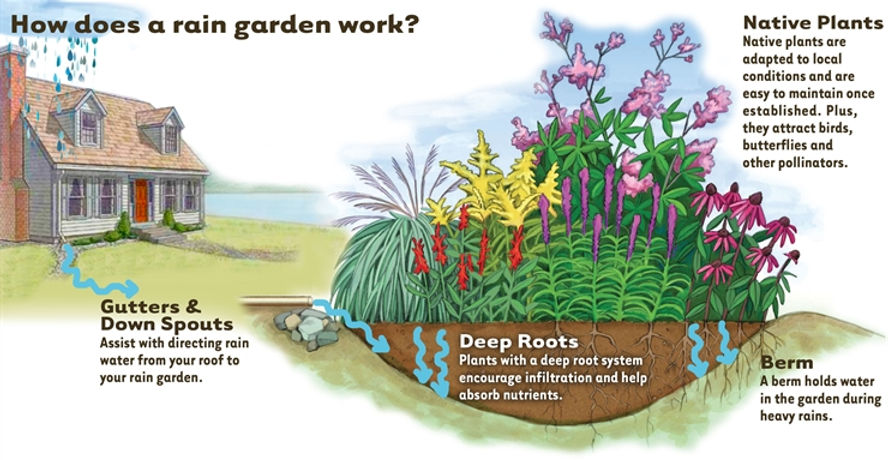

Building Green Homes
Rain Gardens
Storm water is becoming an increasing problem as areas develop and urbanize. Excess storm water can cause problems such as flooding, soil erosion, and thermal stress, which can kill fish. Storm water also increases the amount of sediment, chemicals, debris, and other pollutants that make their way either to a storm sewer or into a body of water. Most water that enters storm sewer systems enter untreated, directly into the bodies of water where people fish, swim, and derive drinking water. Rain gardens are a great way to minimize the damaging effects of storm water runoff.
Rain gardens are areas of vegetation that absorb the storm water runoff from a patio, driveway, roof, or yard and allow the water to be filtered through the soil rather than run into a storm sewer. Rain gardens allow 30% more water to be absorbed than a traditional patch of grass, which are why they are so effective. These rain gardens provide benefits such as they increase the amount of water that filters into the ground, filling our aquifers. Also they lessen the impact on sewer systems, they are aesthetically pleasing, and they provide habitats for birds, insects, and other small animals.
Rain gardens are inexpensive and require little maintenance if planned properly. Rain gardens are either placed near the house to catch roof water runoff or further from the home to catch runoff from the yard and roof. If rain gardens are placed near the home, they should be placed at least 10 feet from the home in order to prevent water from seeping into the foundation. A typical rain garden is between 100 and 300 square feet but any size can work. The smaller the garden the less plant variety possible, and the larger the more money it will cost. An ideal depth of a rain garden is between 4 and 8 inches. Anything less than 4 inches is not sufficient to allow for proper infiltration for large storms and anything larger than 8 inches could pond water or be a tripping hazard. Making the rain garden level, no matter which depth, is key. Sandy soil will infiltrate water the quickest, while clay soil will infiltrate water the slowest. So for clay soils the rain garden should be larger in size than for sandy soil gardens.
Rain gardens not only help mitigate storm water run off, but they act as an eye-catching, beautiful piece of the yard and neighborhood. When choosing which plants to incorporate in the rain garden consider color, texture, height, and bloom time. It is smart to choose an assortment of grasses, sedges, and rushes along side the other plants and flowers chosen, to allow for root competition. Root competition will let plants follow their normal growth patterns and not out compete or outgrow other the species. Having a variety of plants of different colors, heights, and bloom times will allow the rain garden to be pleasing all year round and add the natural aesthetic beauty of the vegetation.[1]

